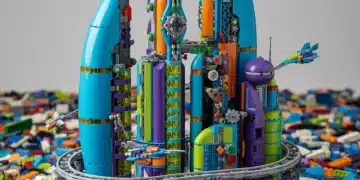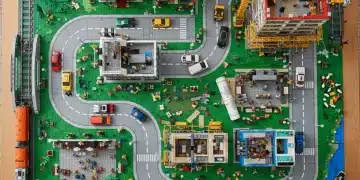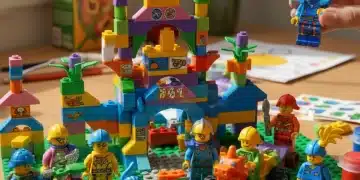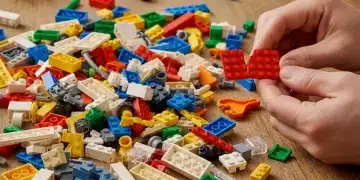Organizing Your Lego Collection: Smart Storage Solutions
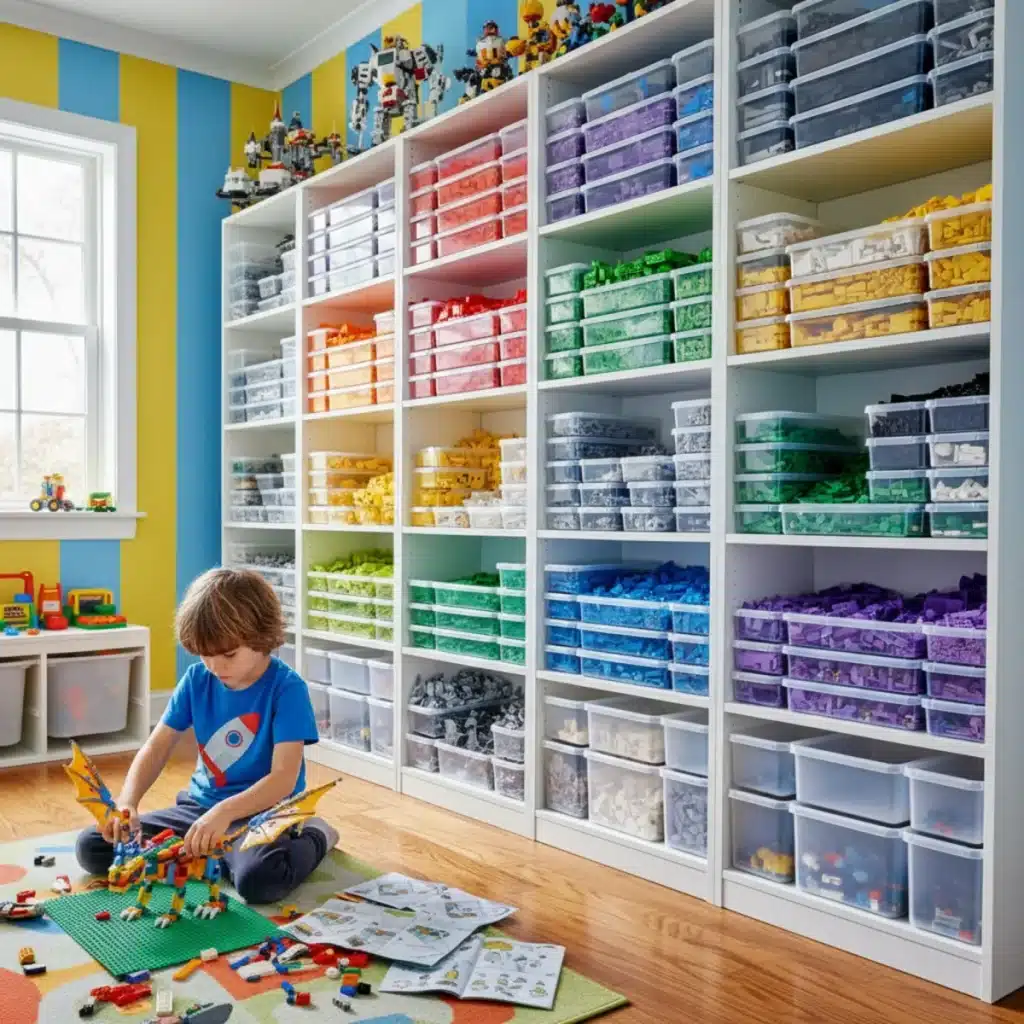
Advertisements
Efficiently organizing your Lego collection transforms chaos into creativity, offering a range of smart storage solutions tailored for every builder, from simple bins to advanced modular systems, ensuring bricks are accessible and play is maximized.
Anúncios
For many, a Lego collection represents endless possibilities and hours of creative fun. However, as collections grow, managing hundreds or even thousands of bricks can quickly turn into a daunting task. The challenge of organizing your Lego collection: storage solutions for every builder is not just about tidiness; it’s about making building more enjoyable and efficient. Finding the right storage system can unlock new levels of creativity, allowing builders of all ages to easily locate the exact pieces they need, fostering a more engaging and less frustrating building experience.
Understanding Your Lego Collection: The First Step to Organization
Before diving into specific storage solutions, it’s crucial to understand the nature of your Lego collection. Every builder has unique habits, preferences, and collection sizes. This initial assessment will guide you toward the most effective organizational strategy, preventing wasted effort and ensuring your chosen system genuinely serves your needs.
Anúncios
Consider the sheer volume of your bricks. Are you dealing with a handful of small sets, or do you have multiple large sets, bulk purchases, and an ever-growing assortment of individual pieces? The scale of your collection directly impacts the type and quantity of storage you’ll require. A small collection might thrive with a few simple bins, while a massive one demands a more sophisticated, multi-tiered approach.
Assessing Collection Size and Type
- Small Collections: Often consist of a few complete sets or a modest number of loose bricks. These are typically easier to manage and don’t require extensive sorting.
- Medium Collections: Include several sets, some loose bricks, and perhaps a growing interest in MOCs (My Own Creations). These collections start to benefit from basic sorting.
- Large Collections: Characterized by numerous sets, bulk buys, and a significant quantity of diverse elements. These absolutely require a robust sorting and storage strategy to remain functional.
Beyond quantity, think about the types of pieces you own. Do you have a lot of specialized elements like Technic pins, minifigure accessories, or rare colors? Are you prioritizing keeping sets together, or do you prefer to sort by piece type and color for free building? Your building style and goals will heavily influence your sorting categories.
Understanding these fundamental aspects of your Lego collection lays the groundwork for successful organization. Without this initial assessment, any storage solution you implement might fall short of your expectations, leading to renewed clutter and frustration. Take the time to genuinely evaluate what you have and how you use it.
Sorting Strategies: Finding What Works for You
Once you have a clear picture of your collection, the next step is to choose a sorting strategy. This is often the most time-consuming part of the organization process, but it’s also the most critical. A well-thought-out sorting system is the backbone of any effective Lego storage solution.
There’s no single “right” way to sort Lego; the best method is the one that makes sense to you and facilitates your building process. Some builders prefer sorting by color, while others swear by sorting by piece type. Many adopt a hybrid approach, combining elements of both.
Sorting by Color vs. Sorting by Piece Type
Sorting by color is visually appealing and can be a good starting point for younger builders or those with smaller collections. It makes it easy to find all the red bricks, for instance, when building a fire truck. However, for more complex builds, finding a specific 1×2 red plate among a pile of red bricks can still be challenging.
- Advantages of Color Sorting:
- Visually intuitive and aesthetically pleasing.
- Good for quick builds where color is the primary concern.
- Can be less intimidating for beginners.
- Disadvantages of Color Sorting:
- Difficult to find specific piece types within a large color pile.
- Many pieces come in multiple colors, making decisions tricky.
- Can lead to more rummaging in larger collections.
Sorting by piece type, on the other hand, is generally favored by experienced builders and those with larger, more diverse collections. This method involves grouping all 1×2 bricks together, all plates together, all slopes together, and so on, regardless of color. This allows for precise part retrieval, which is essential for detailed MOCs.
A hybrid approach often proves most effective. This might involve sorting larger, common pieces by type (e.g., all 2×4 bricks together) and then further sorting specialized or smaller pieces by both type and color (e.g., all 1×1 round plates, then by color). The key is to experiment and find what minimizes your search time and maximizes your building time.
Container Choices: From Budget-Friendly to Professional Grade
With your sorting strategy in mind, it’s time to choose the right containers. The market offers a vast array of options, catering to every budget and organizational philosophy. From simple, affordable bins to sophisticated modular systems, the right container can make all the difference in maintaining an organized Lego space.
When selecting containers, consider durability, visibility, and stackability. Clear containers are often preferred as they allow you to see the contents at a glance, reducing the need for labels or extensive searching. Stackable containers are excellent for maximizing vertical space, especially in smaller rooms.
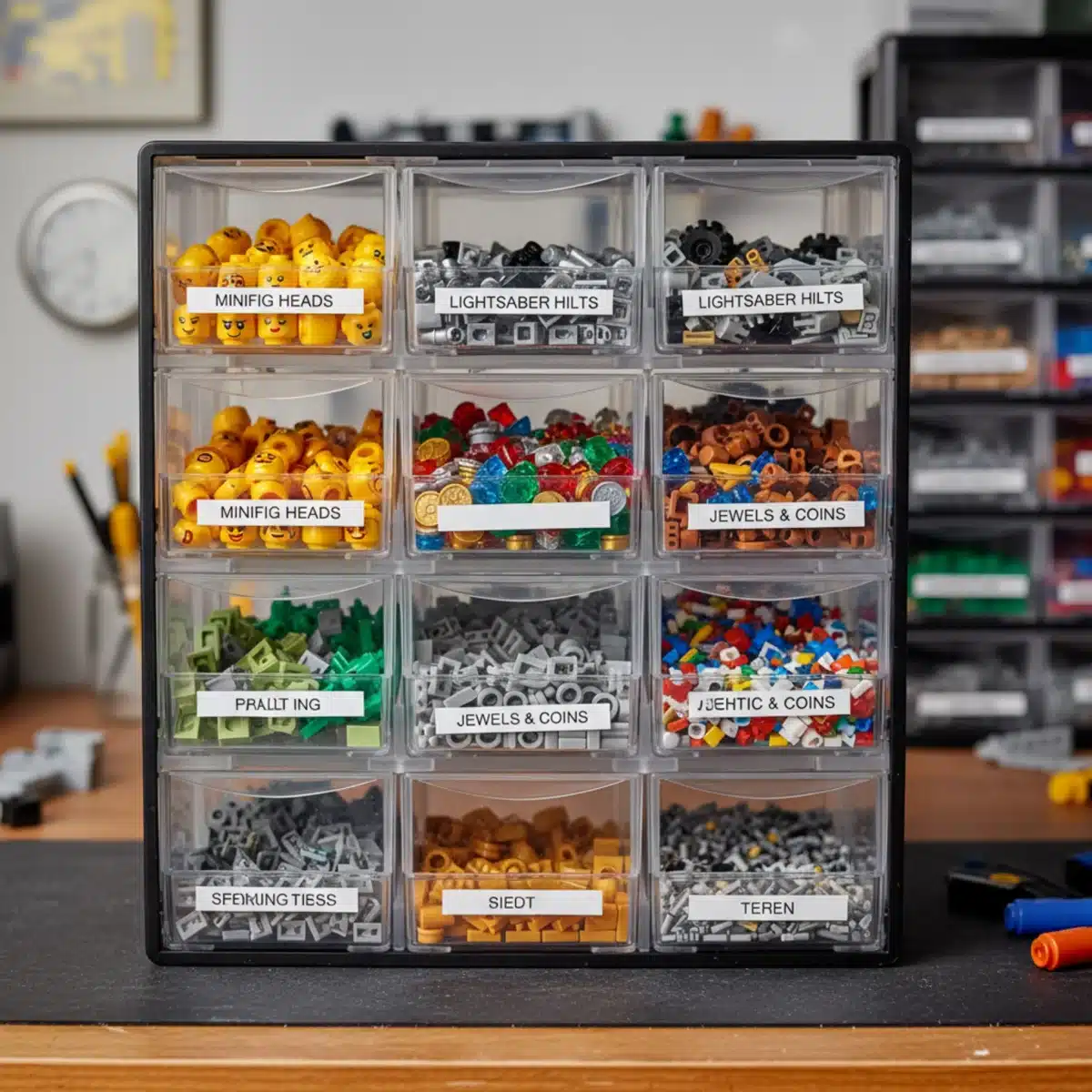
Popular Storage Container Types
- Plastic Bins with Lids: These are a classic choice, affordable and available in various sizes. They are great for bulk storage of larger, less frequently used pieces or for holding unsorted batches. Look for bins with secure lids to prevent spills and dust.
- Drawer Units: Clear plastic drawer units, often found in craft or hardware stores, are excellent for sorting smaller, specialized pieces. Their multiple compartments allow for granular sorting by type or color, and the clear drawers mean you can see everything without opening them.
- Modular Storage Systems: Brands like Akro-Mils or similar hardware organizers offer small, removable bins that fit into larger frames. These are ideal for very detailed sorting, allowing you to pull out only the specific bin you need. They are highly customizable and expandable.
Another innovative solution involves utilizing soft-sided containers or bags for specific purposes. For instance, drawstring play mats that double as storage bags are perfect for younger builders, allowing for quick clean-up by simply pulling the strings. Fabric bins can also be aesthetically pleasing for visible storage in a living space.
Ultimately, the best container choice will be a mix of types, tailored to the specific categories of your sorted Lego. Don’t be afraid to combine different solutions to create a system that is both functional and visually appealing. Remember, the goal is to make your Lego accessible and your building process enjoyable.
Optimizing Your Space: Layout and Accessibility
Having the right containers is only half the battle; how you arrange them within your building space is equally important. Optimized space planning ensures that your organized Lego collection is not only tidy but also highly accessible, making your building sessions more fluid and enjoyable. Consider the flow of your workspace and how you interact with your bricks.
Vertical storage is often overlooked but incredibly effective, especially in smaller rooms. Shelving units, wall-mounted organizers, and even under-bed storage can significantly expand your organizational capacity without cluttering floor space. The goal is to make every piece reachable without excessive effort.
Designing an Efficient Lego Workspace
- Dedicated Building Area: If possible, designate a specific area for Lego building. This could be a desk, a corner of a room, or even a large mat that can be easily rolled up. A dedicated space signals that it’s time to create.
- Ergonomics of Access: Place frequently used pieces at arm’s reach. Less common or bulk pieces can be stored higher up or in less accessible spots. Think about how you sit or stand while building and arrange your storage accordingly.
- Labeling System: Regardless of how well you sort, clear and consistent labeling is paramount. Use labels that are easy to read and understand, perhaps with small illustrations for younger builders. This saves time and reduces frustration.
For builders who work on multiple projects simultaneously, consider portable storage solutions. Tackle boxes or multi-compartment carrying cases are excellent for keeping project-specific pieces together, allowing you to move your work from one area to another without losing critical elements. This flexibility can greatly enhance your building experience.
Don’t forget about display options. Part of the joy of Lego is showcasing completed models. Integrate display shelves or cases into your storage plan. This not only celebrates your creations but also motivates future building. A well-designed Lego space is a blend of practical storage and inspiring display, all contributing to a seamless creative process.
Maintaining Your System: Tips for Long-Term Organization
Establishing an effective Lego organization system is a significant achievement, but maintaining it requires ongoing effort and discipline. Without a commitment to regular upkeep, even the best system can quickly revert to a state of chaos. Consistency is key to long-term success in keeping your Lego collection tidy and functional.
One of the most crucial aspects of maintenance is the “one brick at a time” philosophy. When you’re done building, take a few extra minutes to put pieces back in their designated spots rather than leaving them in a general pile. This small habit prevents large-scale sorting tasks from accumulating.
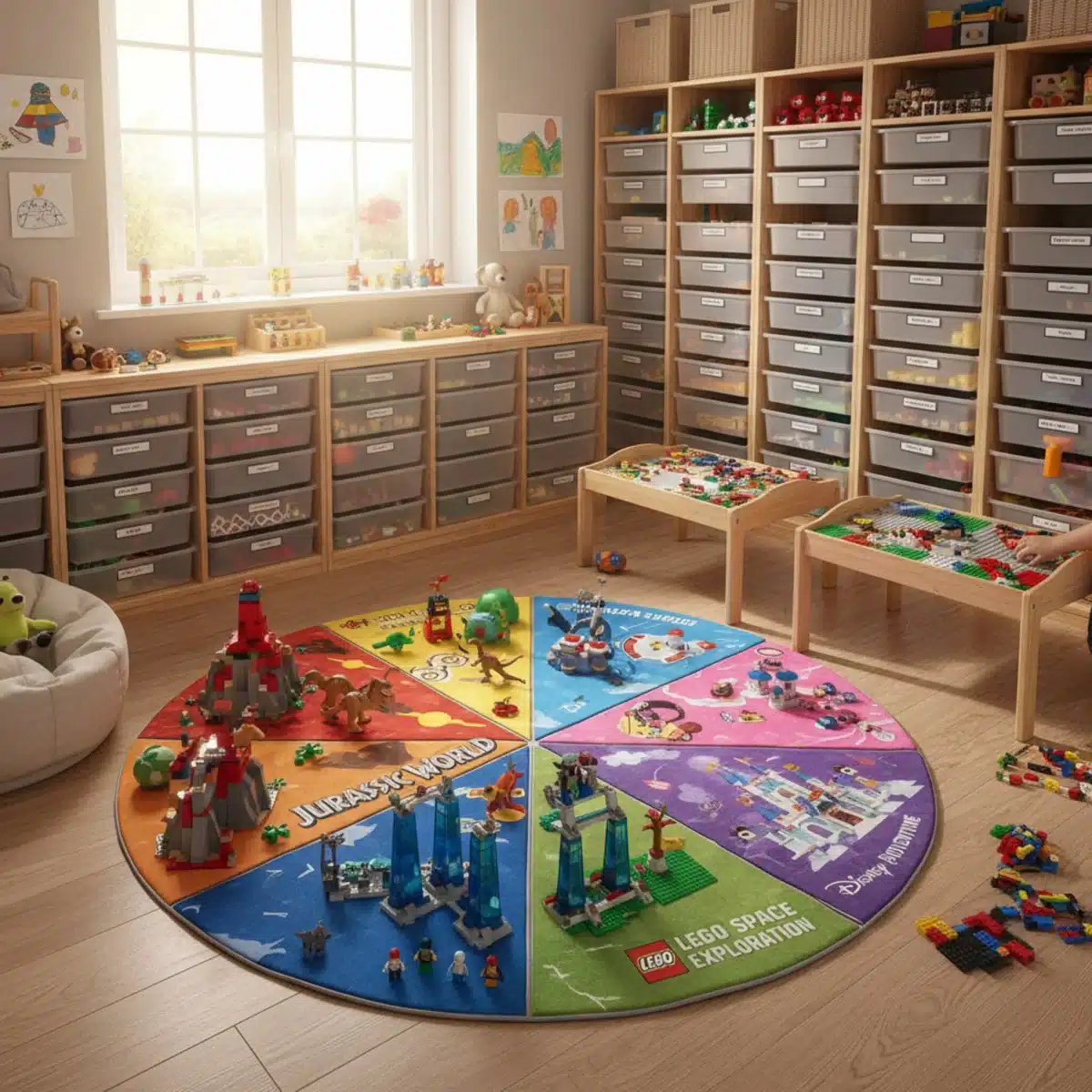
Strategies for Sustained Tidiness
- Regular Purges and Re-evaluation: Periodically review your system. As your collection grows or your building habits change, your organizational needs might evolve. Don’t be afraid to adjust categories, add new containers, or even declutter unused pieces.
- Involve All Builders: If multiple people use the Lego, ensure everyone understands and adheres to the sorting system. Clear rules and expectations can prevent confusion and maintain order. Make clean-up a shared responsibility.
- “Quarantine” Bin for Unsorted Pieces: Have a designated “unsorted” bin for pieces that don’t immediately fit into a category or for quick clean-ups when time is short. Schedule a regular time (e.g., once a week) to sort through this bin.
Dust is another enemy of a clean Lego collection. Regular dusting of your storage units and displayed models will keep them looking their best and prevent grime from building up on bricks. For very dusty pieces, a gentle wash with mild soap and water can restore their shine, but ensure they are completely dry before returning them to storage.
Consider creating a simple inventory system for rare or highly sought-after pieces. This could be a spreadsheet or a dedicated app, helping you keep track of valuable components and preventing accidental loss. A well-maintained Lego collection is a joy to behold and an inspiration for countless building adventures, making the effort worthwhile.
Creative and Budget-Friendly Storage Hacks
Organizing your Lego collection doesn’t have to break the bank. Many effective storage solutions can be created or adapted using common household items or budget-friendly purchases. Creativity and resourcefulness can go a long way in designing a system that is both functional and economical.
Think outside the traditional storage box. Repurposing items like old tackle boxes, craft organizers, or even kitchen containers can provide surprisingly effective and specialized storage for various Lego elements. The key is to see potential in everyday objects.
DIY and Affordable Storage Ideas
- Clear Food Storage Containers: Plastic food containers with snap-on lids are excellent for sorting small to medium-sized groups of bricks. They are often stackable, transparent, and relatively inexpensive.
- Wall-Mounted Jars or Bins: For very small pieces like studs, tiles, or minifigure accessories, clear jars or small bins mounted to a pegboard or a strip of wood can offer visible and accessible storage.
- Shoe Organizers: Over-the-door shoe organizers with clear pockets are fantastic for storing minifigures, small builds, or even individual sorted categories of bricks. They utilize vertical space and keep items visible.
Another clever hack involves using large, zippered mesh laundry bags for storing instructions or partially disassembled sets. This keeps them together and protected, yet still breathable. For instruction manuals, binder clips and a hanging file system can keep them neat and easily accessible without getting bent or torn.
Consider using existing furniture. Bookshelves can be repurposed for displaying completed models or housing storage bins. Under-bed storage containers are perfect for seasonal sets or bulk pieces that aren’t frequently accessed. With a little imagination, you can transform ordinary items into extraordinary Lego organizational tools, proving that effective storage doesn’t always require a hefty investment.
Integrating Technology: Digital Tools for Builders
In an increasingly digital world, technology offers powerful tools to enhance the organization and management of your Lego collection. Beyond physical storage, digital solutions can help you catalog your bricks, track your sets, and even plan your next build with unparalleled precision. Integrating these tools can take your organizational efforts to the next level.
Several online databases and apps are specifically designed for Lego enthusiasts. These platforms allow you to log your sets, track which parts you own, and even manage your inventory for MOC building. This digital layer of organization complements your physical storage, providing a comprehensive overview of your entire collection.
Leveraging Digital Resources for Lego
- BrickLink and Brickset: These robust online databases are invaluable. BrickLink allows you to inventory your parts, track sets, and even buy/sell individual pieces. Brickset provides detailed set information, instructions, and a way to catalog your collection.
- Rebrickable: This site helps you discover new MOCs you can build with the pieces you already own, based on your inventoried collection. It’s a fantastic tool for maximizing the potential of your existing bricks.
- Spreadsheets or Dedicated Apps: For a more personalized approach, a simple spreadsheet can be used to track specific parts, colors, or quantities. There are also various third-party apps available that offer similar inventory management features.
Digital tools can also assist in planning and conceptualizing builds. Programs like Stud.io by BrickLink allow you to design digital Lego models using a vast library of virtual bricks. This not only helps in planning complex MOCs but also serves as a digital inventory, showing you exactly which pieces you’ll need before you even touch a physical brick.
The beauty of integrating technology is its ability to provide a birds-eye view of your collection, making it easier to identify gaps, plan purchases, and rekindle creativity by discovering new building opportunities. While physical organization keeps your space tidy, digital tools empower you with knowledge and insight into your plastic treasure trove.
| Key Aspect | Brief Description |
|---|---|
| Collection Assessment | Evaluate size, types of pieces, and building habits to determine optimal storage needs. |
| Sorting Strategies | Choose between sorting by color, piece type, or a hybrid approach to maximize efficiency. |
| Storage Containers | Select durable, visible, and stackable containers like bins, drawers, or modular systems. |
| Maintenance & Tech | Implement regular upkeep, involve builders, and utilize digital tools for inventory management. |
Frequently Asked Questions About Lego Organization
Begin by sorting large pieces from small, then separate unique elements. Gradually move to sorting by general type (bricks, plates, slopes) before delving into color or more specific sub-categories. This phased approach prevents overwhelm and builds momentum for larger collections.
For smaller collections or younger builders, color sorting is often visually appealing and easy. However, for larger collections and serious builders, sorting by piece type (e.g., all 2×4 bricks together) is generally more efficient for finding specific parts quickly. A hybrid approach often works best.
Repurposed clear food containers, tackle boxes, craft organizers, and over-the-door shoe organizers are excellent budget-friendly options. Utilizing existing bookshelves or under-bed storage also helps save money while providing effective organizational space for your bricks.
Store Lego in containers with secure lids to prevent dust accumulation. Regularly dust shelves and display cases. For displayed models, consider using glass display cabinets. For very dusty pieces, a gentle wash with mild soap and water, followed by thorough drying, can restore their cleanliness.
Yes, websites like BrickLink and Brickset allow you to catalog your sets and parts, manage inventory, and track your collection. Rebrickable helps you discover new builds from your existing pieces. These digital tools complement physical organization by providing a comprehensive overview.
Conclusion
Successfully organizing your Lego collection: storage solutions for every builder is a journey that transforms potential chaos into a vibrant, accessible, and inspiring creative space. By taking the time to assess your collection, implement a thoughtful sorting strategy, choose appropriate containers, and optimize your physical space, you lay the groundwork for countless hours of joyful building. Remember that maintenance is key to long-term success, and don’t shy away from creative, budget-friendly hacks or integrating digital tools to enhance your organizational efforts. Ultimately, a well-organized Lego collection isn’t just about tidiness; it’s about fostering creativity, reducing frustration, and ensuring that every brick is ready to play its part in your next imaginative construction. Embrace the process, and watch your building adventures flourish.
